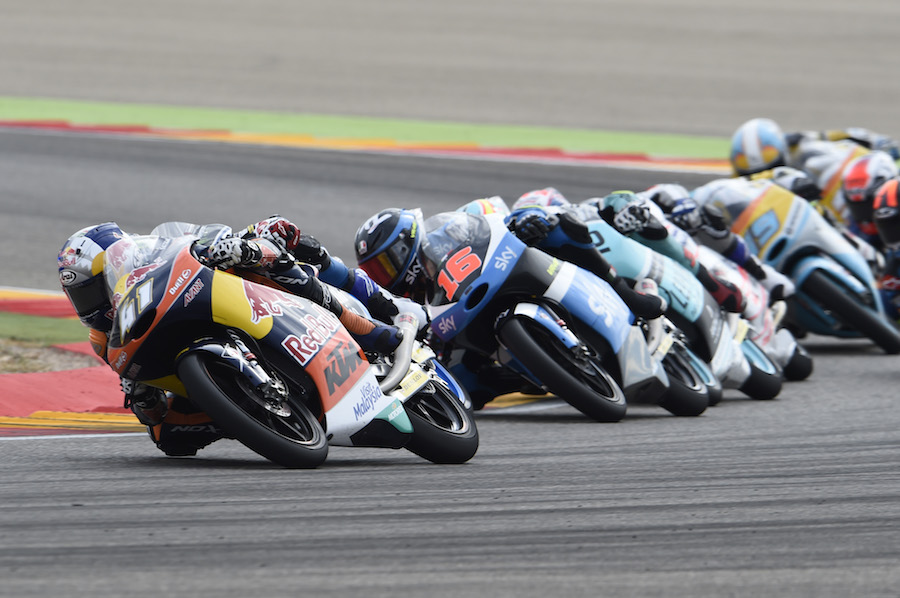Unlike the proddie-powered humbugs of Moto2, Moto3 bikes are proper grand prix racers
What makes a good motorcycle race? The artistry and genius when a rider leaves the rest for dead? Or a bruising tussle, won by the rider with the biggest elbows in the last corner?
Tricky question.
I’m not sure. Having been trackside for the dominance of Doohan, I was lost in respect, if not particularly excited. For enjoyment, Rainey versus Schwantz took some beating.
Then there’s Rossi. In his pomp, he understood that both were to be admired. He knew how to make a race of it, even when he knew he was going to win.
So let’s go for excitement rather than awe.
And let’s look at Moto3.
I recall greeting them with some scorn. They sounded like lawnmowers with an exhaust leak.
Boy was I wrong. Not about the sound, maybe, but everything else. All the things that really matter about world championship racing.
The bikes are little gems. Dorna’s low-cost plan was soon defenestrated when KTM decided that they could go their own way on development costs, and sell every one at a loss, if they wanted.
Honda, who originally produced a very workaday little production racer in the spirit of the rules, huffed and puffed, then did the same thing. Mahindra followed suit.
Unlike the proddie-powered humbugs of Moto2, Moto3 bikes are proper grand prix racers. Most importantly, the gearing is adjustable. Which gives both engineers and riders something to think about and learn. And there’s more than just one type of engine.
Moto3 takes simplicity to a high level. I remain intrigued by the fact that the end result closely resembles the single-cylinder Manx Norton, the RCV or M1 of its day, good enough to win the 500cc championship for Geoff Duke in 1951. A Moto3 bike makes more or less the same horsepower from the same number of cylinders – one, albeit half-sized. But it’s lighter, much better tyred and braked, and significantly faster. Yet it is considered a learner-racer, suitable for novices in their early teens. Some progress in humans then, as well as engineering.
This is reflected in this year’s crop of super-rookies. In Moto3, unlike the CEV “Junior World Championship” or Red Bull Rookies. whence these youngsters came, the minimum age is 16.
The average age this year, at the opening round, was just less than 18 and a half. Including one rider (Masbou) at the maximum of 28. The average of the eight winners of the first 14 races was 19.4, John McPhee (Brno) the oldest at 21.
It could fall further next year, thanks to an amazing group of rookies. There are 10, and several are truly remarkable. Khairul Idham Pawi (17) has won twice; Joan Mir (18) once, from pole. He’s fourth overall, ahead of Nicolò Bulega (just 16), and Fabio Di Giannantonio (17). Not far behind, Bo Bendsneyder and Arón Canet.
All of which throws an even sharper focus on the remarkable achievement of world champion Brad Binder.
In this maelstrom of manic teenagers, he’s won five races and the title with four to spare, making him the first South African champion since Jon Ekerold in 1980. His greatest achievement was not just winning at Jerez from last on the grid (a technical penalty), but leaving the lead group trailing by almost 3.5 seconds in a year when winning margins have four times been less than a tenth, another five times less than half a second, and once 0.007.
It takes maturity and racecraft to rack up win after win in these circumstances. He moves on now to Moto2.
Former Moto3 stars have either foundered or flourished in the downbeat middle class. Rins and Viñales were winners. Likewise Márquez. It’s not necessarily a bad finishing school, but not as good as Moto3.
Just ask Jack Miller.

Brad Binder, Aragon Moto3 Race 2016
By MICHAEL SCOTT